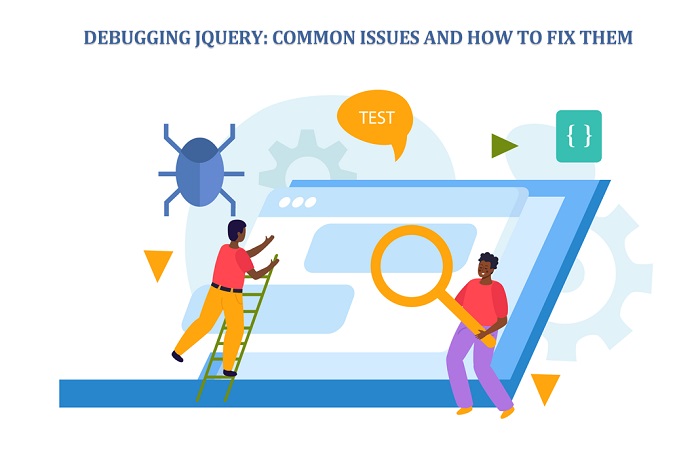Are you struggling with jQuery code that’s not behaving as expected? Don’t worry; debugging jQuery is a common challenge for developers, but you can overcome it with the proper knowledge and techniques. In this discussion, we will explore some of the most common issues encountered when working with jQuery and provide practical solutions to fix them.
Whether you’re dealing with syntax errors, selector problems, event handler issues, or AJAX requests gone awry, we’ll guide you through the debugging process step by step. So, let’s dive in and unravel the mysteries of jQuery debugging together!

1. Syntax Errors
Syntax errors occur when your code doesn’t follow the proper syntax rules of JavaScript or jQuery. These errors can prevent your code from running or cause unexpected behavior.
To fix syntax errors, carefully review your code and check for missing or misplaced brackets, parentheses, semicolons, or quotation marks. You can also use an integrated development environment (IDE) or code editor with syntax highlighting to identify errors as you type.
Most modern browsers have developer tools that can provide error messages with specific details about the syntax error, allowing you to pinpoint and fix the issue.
2. Selector Not Targeting Elements
jQuery selectors are used to target specific details in the DOM. If your selector is incorrect, it won’t find the desired features, and your code might not work as expected.
To resolve this issue, review your selector and ensure it matches the HTML structure and attributes of the elements you want to target. You can use the ‘$()’ function or ‘jQuery()’ function to test your selector in the browser’s developer console and verify if it returns the expected elements.
Also, you can log the selected elements using ‘console.log()’ or ‘console.dir()’ to inspect them and confirm if they match your expectations.
3. Event Handlers Not Working
jQuery event handlers allow you to bind functions to specific events, such as clicks, form submissions, or keypresses. If your event handlers like WooCommerce stock manager aren’t triggering as expected, there may be a problem with how you’ve bound them or the events themselves.
To fix this issue, double-check that you’ve used the correct event name (e.g., “click,” “change,” “submit”) when binding the handler. Ensure that the elements to which you’re binding the events exist in the DOM when the binding occurs. The ‘$().on()’ method can delegate affairs to dynamically added elements.
You can also place ‘console.log()’ statements within the event handler function to check if they are being triggered when the event occurs. This can help identify whether the issue lies with the event binding or the code inside the handler.
4. AJAX Requests Not Functioning
jQuery provides convenient methods for making AJAX requests to the server and handling the responses. If your AJAX requests are not working, there may be issues with the URL, parameters, or the server’s response.
To troubleshoot, examine your AJAX request configuration and verify that the URL and parameters are correct. Use the browser’s developer tools to inspect the network requests and responses.
Look for any error messages in the console or the network tab. If the server is not responding as expected, you may need to check your server-side code to ensure it appropriately handles the request and returns the desired data or status codes.
You can also use the ‘$.ajax()’ method’s error callback to log any errors or failures in the AJAX request and investigate further.
5. Conflict With Other Libraries
jQuery may encounter conflicts with other JavaScript libraries that use the same global variables or have conflicting methods.
You can use jQuery’s ‘noConflict()’ method to resolve conflicts. This method releases control of the ‘$’ variable, allowing other libraries to use it without friction. After calling ‘.noConflict(),’ you can use the jQuery keyword instead of ‘$ ‘to reference jQuery objects and methods.
Another approach is to use a module bundler like Webpack or a library like RequireJS to manage dependencies. These tools provide mechanisms to avoid global namespace conflicts and ensure each library operates in its scope.
6. Asynchronous Behavior
jQuery provides both synchronous and asynchronous methods for various operations. Understanding the difference and using the appropriate form based on your needs is essential.
Synchronous methods, such as ‘.ajax()’ with async: false, block the execution of other JavaScript code until the operation completes. On the other hand, asynchronous methods allow other code to continue executing while the process is in progress.
It can lead to unexpected issues if you expect asynchronous behavior but use a synchronous method or vice versa. Review the jQuery documentation for your specific techniques and ensure they align with your intended behavior.
7. Outdated Version
Using an outdated version of jQuery can lead to bugs or a lack of support for newer features. It’s essential to keep your jQuery version up to date. Updating to the latest stable version ensures you have access to bug fixes, performance improvements, and any new features introduced by the jQuery team.
When updating, it’s essential to review the release notes for the new version to identify any backward-incompatible changes that may require updates to your code. jQuery’s official website and GitHub repository provide documentation and resources to help you with the upgrade process.
8. Debugging Tools
When debugging jQuery, leveraging the available tools can greatly assist in identifying and resolving issues. Most modern web browsers have built-in developer tools that offer various features to help debug JavaScript and jQuery code.
The console helps log values and errors and execute code snippets. You can use ‘console.log()’ or ‘console.dir()’ to print messages or inspect objects and variables at different points in your code. The network tab allows you to monitor AJAX requests and responses, helping you identify any issues with the server communication.
You can also set breakpoints in the code to pause execution and inspect variables, step through the code line by line, and analyze the program flow.
Conclusion
Debugging jQuery code is essential for developers working with this popular JavaScript library. Addressing common issues and understanding how to fix them can save time and frustration in your development process.
Remember to double-check for syntax errors, ensure your selectors are targeting the correct elements, verify event handlers are bound correctly, and troubleshoot any problems with AJAX requests.
Also, be mindful of conflicts with other libraries, understand the difference between synchronous and asynchronous behavior, keep your jQuery version current, and utilize the powerful debugging tools available in modern web browsers.
With these strategies and techniques in your toolkit, you’ll be well-equipped to tackle any challenges while working with jQuery. Happy debugging!




